Film of the Week: Split
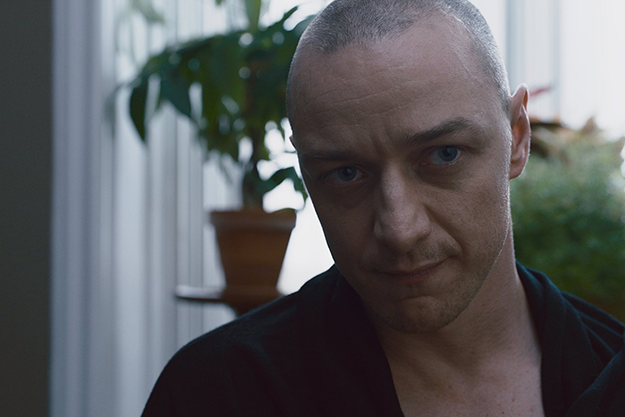
I’ve spent the last decade staying away from the films of M. Night Shyamalan. I loved his early ones, even the much-maligned The Village, with its insane double twist and loopy Hawthorne-meets-Lovecraft imagery. But, like many people, I found my patience tested beyond endurance by Lady in the Water (or, as I prefer to call it, Vamp From the Damp), a film at once pompous, insipid and—let it be said once and for all—wrong, so wrong, about film critics.
Anyway, having missed found-footage chiller The Visit—which many hailed as a refreshing back-to-basics number—I came to Shyamalan’s Split prepared for anything. I wasn’t expecting a last-minute twist of the sort that he painted himself into a corner with years ago, but in fact the film concludes with something decidedly odder—a throwaway coda in which a former Shyamalan star ruefully turns up to acknowledge an allusion to one of MNS’s earlier movies. It is, I suppose, the director’s way of saying, “Didja miss me?”
Well, let it be said, Split is kind of refreshing. It’s also preposterous, contentious for various reasons, and altogether derivative. That is to say, it’s derivative in a whole-hearted way that takes a lot of stuff you’ve seen before and pushes it to an absurd extreme—not in the manner of Tarantino-esque intertextual knowingness, but in the sense that Shyamalan seems to think he can make this material deeper, more resonant, altogether more significant than elsewhere. If that’s what he does think, he’s wrong—Split is essentially silly and paper-thin—yet Shyamalan goes about his business here with a mixture of seriousness and exuberance that’s never less than entertaining and arresting.
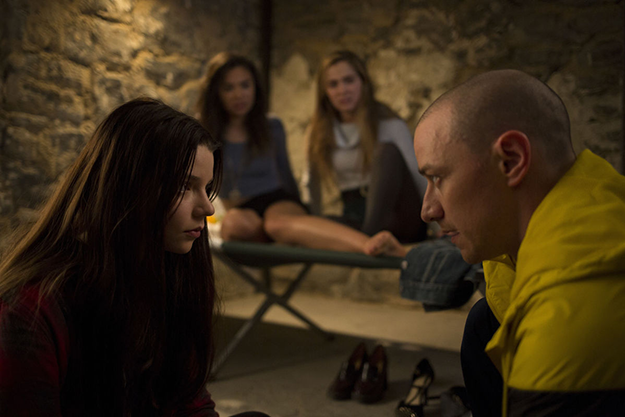
The theme is dissociative identity disorder (DID), previously known as multiple personality disorder, a condition that causes people’s selves to fragment into multiple personas. It’s still a much-debated phenomenon, but Shyamalan’s premise here is that DID is not only real and to be taken seriously, but that it might also potentially be—for the purposes of storytelling, at least—some kind of superhuman capacity. The film’s villain is Kevin, a youngish man played by James McAvoy—who also plays Kevin’s “alters,” including Patricia, Hedwig, Barry, and assorted others. I was particularly disappointed not to make the acquaintance of the formal-sounding “Mr. Pritchard”; I hoped we’d get to hear McAvoy do a terribly proper Kelsey Grammer voice.
The premise is the old girls-kidnapped-by-dangerous-predator routine. Three young women get abducted from a car park by Kevin’s most Norman Bates-ish self, Dennis. Two of them are too busy fiddling with their mobiles to even notice that Dennis has got into their car. The third, Casey (Anya Taylor-Joy), is the only one to register this at first—but she’s set up from the opening first moments as the film’s Final Girl. An overtly Hitchcockian track in and zoom out defines her as separate from the others, moody, detached, lost in herself. In other words, she’s a refined soul who, because she’s possibly as damaged as Kevin, will be the one to tackle him on his own terms.
Shyamalan puts on a decent show of avoiding the old exploitative girls-in-peril routine. Locked up in Dennis’s cellar, Claire (Haley Lu Richardson) and Marcia (Jessica Sula) instantly start planning ways to fight back and escape, refusing to countenance “this victim shit.” Casey seems defeatist, however, and doesn’t want to fight back, at least not yet. Shyamalan and DP Michael Gioulakis neatly mark her detachment from the others; a pipe runs down the wall between them, signifying that the titular split of the title isn’t just within Kevin, but within his group of captives.
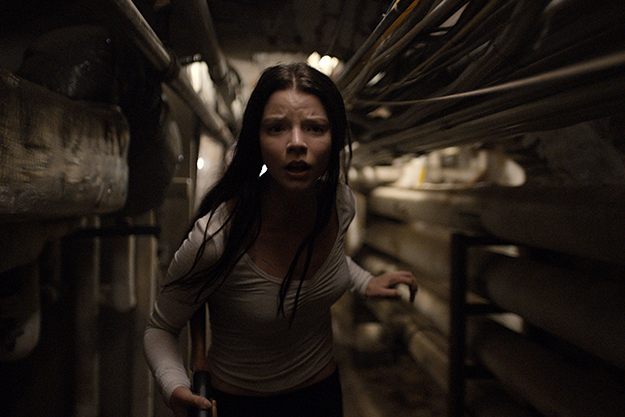
As we meet Kevin’s alters, the film becomes a stage for McAvoy to unleash a whole repertoire of personas—rather like Michael Keaton in Multiplicity, only without the costly CGI. Dennis is the nervous, twitchy, repressed martinet, literally buttoned tightly in a grey shirt. He has OCD hygiene issues (“germaphobes” really haven’t been enjoying great PR this week), and is tormented by a desire to see young women dancing naked, which for the purposes of this film is consistently frustrated. The most charming alter is Barry, a fashion designer played by McAvoy as charming and only moderately camp. Then there’s Hedwig, aged 9, a manic, lisping child who impishly sits on the prisoners’ threshold, and at one point launches into a demented break-dance routine. The most sinister persona of all is Patricia, a silkily menacingly Englishwoman with a penchant for Chinese music and words like “crepuscular”; it’s wonderful to see McAvoy getting in touch with his inner Lindsay Duncan.
While the women make desperate attempts either to escape or to befriend aspects of Kevin, Shyamalan takes the film in two directions. One leads through a series of flashbacks to the secret behind Casey’s withdrawn temperament; expect no surprises. The other concentrates on Kevin’s treatment by therapist Dr. Karen Fletcher—Betty Buckley, doing a marvelous, highly personable job of taking it all seriously. Dr. Fletcher spends a lot of time explaining to us—via Barry, various colleagues and at one point, an international Skype conference—what DID is, and how it might represent the new frontier in the human psyche. “Is this the ultimate doorway to things we call the Unknown?” she speculates; Shyamalan’s script, be warned, is ripe with rhetoric.
I have no idea whether any of the terms Dr. Fletcher uses relate to legitimate scientific discourse on DID, but it seems that Kevin has 23 different identities all trying to access “the light,” and that his self can be represented as a group of people all sitting in circles in a room: it’s as if they’re all jockeying for position, sometimes trying to snitch on each other. Dr. Fletcher refers to them as “the Horde,” which seems both Gothically ominous and a little negative: perhaps if they’d been known as “the Community,” or “the Co-op,” they’d all get on a lot better.
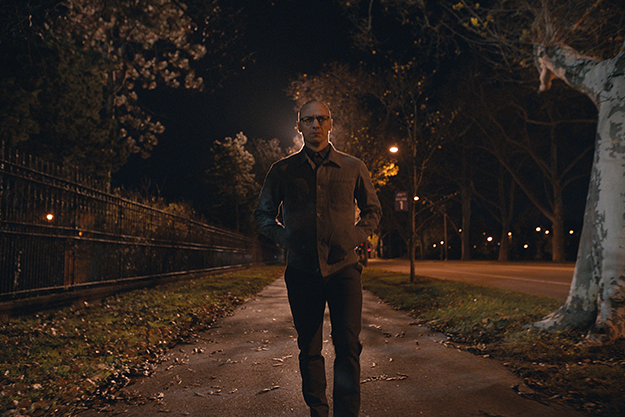
Oh, then there’s persona No. 24, “the Beast,” whom everyone is terrified of, and who is apparently on his way with baleful intent—slouching towards Bethlehem to be born, as it were. Dr. Fletcher discounts the Beast as a myth, but we know he’s not—there would be no third act if there were. This monster is surely bound to be McAvoy’s wildest acting riff, and the ultimate illustration of Dr. F’s thesis that some people with DID can modify their body chemistry to literally be the persons they believe they are. The Beast does indeed show up, a kind of floridly ranting Nietzschean lycanthrope (“We are glorious! Only through pain can you achieve your greatness!”), with a few tricks you’d normally only expect to see in a Marvel movie. Shyamalan obviously knows what he’s doing, mixing genres in this way, but the fact that McAvoy is associated with one particular superhero franchise means that it’s hard, when his final persona shows up, not to expect daggers to shoot out of his knuckles as he spontaneously grows a Hugh Jackman quiff (he doesn’t: McAvoy keeps the same skinhead crop for all his personas).
Split takes itself a little too seriously to be entirely convincing: Shyamalan manifestly thinks he’s into something profound, what with all the talk about “the highest form of human evolution” and the consistent riffing on the theme of animality, which all pays off somewhat literally at the end. Mythic touches—allusions to the Bluebeard and Rumpelstiltskin stories—are a bit heavy-handed. And despite the Hitchcockian camera touches at the start, and what seems like a cheerful nod to Dressed to Kill in the character of Patricia, Shyamalan is no De Palma; the most effective suspense touch is the little gap in their cell door that the girls can look through, in which McAvoy suddenly switches from one persona to the next.
Otherwise, Split works effectively as a taut little high-concept thriller. With its small cast and limited range of claustrophobic locations, this is a chamber drama that almost feels like a stage piece. The way that Shyamalan and Gioulakis emphasize close-ups and medium shots make for a taut, clean forcefulness that—along with its clean, stark opening credits—give Split a leaner, hipper feel very different from the increasingly aestheticized studio polish of Shyamalan’s earlier work.
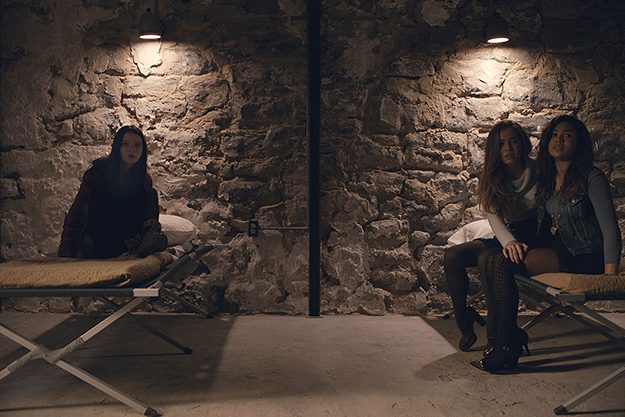
There have, of course, been objections to Split’s use of mental illness and transgender identity in a sensationalizing genre context and, yes, in many ways, Split is the same old same old—although MNS would no doubt object that, as presented here, DID is not an illness but the next stage in human evolution. (By that criterion, shape-shifters like Soderbergh or Linklater would be an infinitely more advanced cinematic species than Hitchcock himself.) Still, purely as a hanger for a range of full-bloodied, characterful performances, Split is never less than engaging, and it certainly raises your eyebrows as to McAvoy’s hitherto unsuspected potential as a new Daniel Day Lewis. As for Anya Taylor-Joy, who was so striking in The Witch, her coolly detached lucidity as Casey gives the film a strong, clear focus, not least because of the candid intensity of her gaze (I wouldn’t rate either Emma Stone’s or Amanda Seyfried’s chances in a staring contest with her). Her intelligent calm helps the film avoid the usual grisly excesses (see Martyrs, also a Blumhouse production) of the female-captivity “victim shit,” although there’s something no less questionable about Split’s notion that only someone damaged can take on, thanks to empathy, a damaged adversary—or that the only way to survive one trauma is to undergo another one. Anyway, perhaps we’ll see how this theme plays out in an eventual Split 2; we might even get to meet Mr. Pritchard.
Jonathan Romney is a contributing editor to Film Comment and writes its Film of the Week column. He is a member of the London Film Critics Circle.







